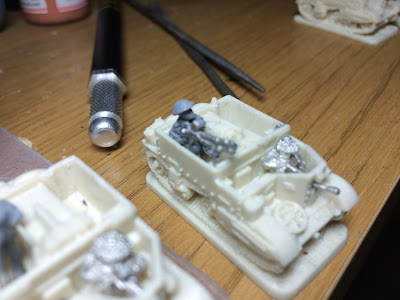New Anglian Confederation (NAC) vessels:
RNS Blore Heath - Lancaster class Light Cruiser
RNS Coatbridge - Fearless class Escort Carrier
- VF543 'Timberwolves' Multi Role Lightning VI fighters
- VF545 'Deathsheads' Multi Role Lightning VI fighters
RNS Doncaster - Tallahachie class Destroyer
RNS Dartmouth - Tallahachie class Destroyer
Umbrella Gygax Corporation (UGC) vessels:
UGC Lumbrant - Battlecruiser
UGC 'Black Herring' - prototype stealth vessel
UGC Ruby - Frigate
Similarly to the first battle, the Nebula consisted of thin dust clouds dotted with asteroids and other space junk. The main things being UGC space mines set up to defend the area.
As per the briefing I had received, I asked my helmsman to study the encoding of the message I received. Although results would not be forthcoming until the end of the battle what was discovered was that the mission was supposed to be delayed. The message I received was due to be transmitted 12 hours later - by which time the UGC ships would have left the vicinity. It seems like there had been some shadowy goings on. Possibly related to UGC's funding of several NAC politicians election campaigns and favors being pulled. It seems that other shadowy figures decided that the NAC's intervention earlier was required.
Again, random flight stands represent hidden deployment and passive sensor contacts that needed to be firmed up by ships getting within 54cm.
As can be seen my deployment was to use the RNS Coatbridge's two escorting Destroyers to escort my two bigger ships. The Blore Heath (at this point my regular flagship) was to go left, while the RNS Coatbridge was to head right and use it's fighters - while keeping it's own distance.
A few turns on and the NAC ships flanking manoeuvres had identifies the UGC ships. Communication was initiated:
Captain James responded, stating that UGC ships had been involved in a terrorist attack on a NAC aligned planet. And ordering the vessels to stand down and prepare to be boarded. Footage of the industrial platforms being decelerated onto the planetary surface was provided, and there was some back and forth, before the reply:
The NAC vessels, facing a brick wall diplomatically due to the UGC corporate AI overriding their captains commands, moved into the attack. Neither side engaged in combat, each waiting on the other to make the first move. Eventually the NAC decided to fire first. The two fighter squadrons, launched earlier and in CAP around the RNS Coatbridge, moved in to attack.
This was a little bit of a silly move, as the NAC ships were all more or less moving away from the bulk of the UGC forces. Caution around the weapons of the Battlecruiser kept them at a distance and moved them to try and get good firing solutions.
The NAC fighters reached the UGC Lumbrant but held orbit, waiting on the go orders. Eventually, the NAC ships reached a firing point, and along with beam attacks on the UGC ship the fighters went in. The first wave of fighter attacks hit hard, stripping the armour off the Battlecruiser and taking it into the first row of hull.
The NAC ships did their best to avoid the Battlecruisers fire, resulting in the RNS Cambuslang taking some damage from a mine it strayed too close to. The RNS Blore Heath and RNS Doncaster turned in, trying to get decent arcs on the BC and turn towards the stealth ship. In the mean time the stealth ship and frigate started to accelerate.
As the NAC ships tried to turn and get back into the fight, the fighters kept up their attacks - each attack run causing significant damage. The second round of attacks caused a line check which caused one of the Advanced Shields to fail. This meant that more damage from the fighters started to break through (it basically meant that any rolls of 6 to hit did 2 points of damage and 'exploded', causing another roll. Another 6 did another 2 points of damage and another roll. Etc). This was the start of a cascade failure for the lumbering UGC ship.
With the UGC stealth ship and frigate building up speed, the RNS Blore Heath struggled to turn with it's escort. The RNS Coatbridge just tried to stay out of the fight.
Captain James called upon the Battlecruisers crew to surrender before their vessel was destroyed, but only received an automated reply from the AI. The fighters committed to their final attack, leaving the heavy ship a gutted wreck.
Meanwhile, the UGC Frigate entered FTL, getting away. The Stealth ship kept accelerating while the RNS Bosworth and RNS Doncaster gave chase - but they were at a disadvantage in speed and the Nebulae rapidly gave the stealth ship the cover it needed to hide. With no jump engine however, it's fate was uncertain, while the NAC ships and fighters would keep hunting it.
For now the battle was over, the UGC had suffered a bloody nose (after my face got smashed in the first time we played!) and the UGC learnt the dangers of fighter attacks on lightly PDS armed capital ships.
A good game, although I felt that the balance had swung too far to the NAC side. While C seemed fine with it, we had both made mistakes and I think the nastiness of fighters in the system was a bit of a shock to both of us. His prep work had been excellent - especially the sound recordings he made (check them out if you haven't already!).
The next game is being plotted in my head. It looks like we will both be speccing out fleets to play scenario's with (but not necessarily against each others fleets). The UGC will be undertaking contracts to get money to purchase new ships, while the NAC ships will be undertaking missions for promotion prospects and new vessels.






























